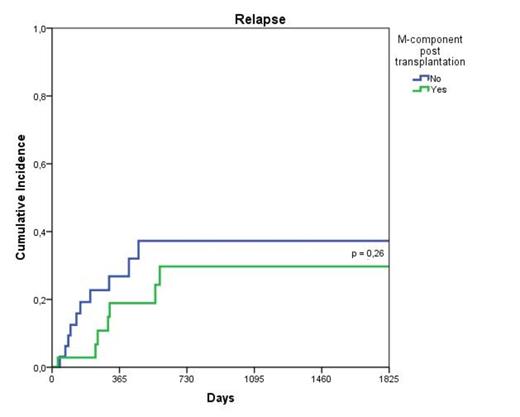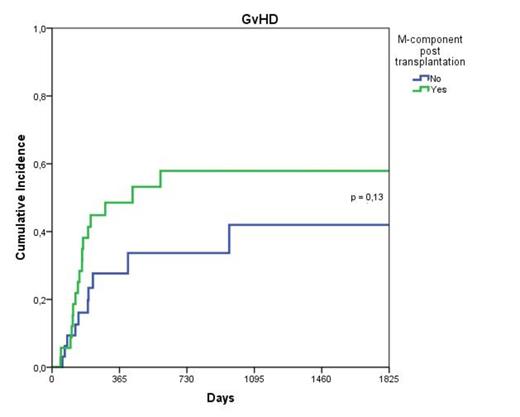Abstract
Transient monoclonal gammopathy is a common alteration of laboratory test after allogeneic stem cells transplantation (alloBMT). However, until now, only scattered works have been published about it. The main paper reported on PubMed, regarding transient monoclonal gammopathy, was presented by the Dana Farber's group at the end of the eighties. The author of that paper showed an apparently strong correlation between development of graft versus host disease (GvHD) and appearance of a monoclonal gammopathy. Starting from that observation, we decided to evaluate among our allogeneic transplanted patients the incidence of M-component and its possible relationship with GvHD.
67 patients undergoing alloBMT at the Haematology Unit of Alessandria (Italy) between 2006 and 2010 were evaluated: 52% of patients were male and 48% were females. Pre-transplantation diagnosis included: 34 acute myeloid leukaemia (50.7%), 8 acute lymphoblastic leukaemia (11.9%), 7 non-Hodgkin Lymphoma (10.4%), 6 chronic leukaemia (9%), 4 myelodysplastic syndrome (6%), 2 Hodgkin lymphoma (3%) and 6 other less common malignancies (9%). All patients had, at least, two pre-transplantation serum electrophoresis with no evidence of pre-existing monoclonal component; for the analysis, we haven’t considered patients submitted to alloBMT for myeloma. Controls of serum electrophoresis were performed at 90, 180 and 360 days after transplantation. In our survey, 17 patients relapsed after alloBMT, 27 patients developed GvHD and 26 patients died. Post-transplantation follow up ranged from 81 to 2514 days with a median of 496 days.
As a whole, 35/67 (52%) of the patients developed monoclonal gammopathy after transplantation. Comparing patients with or not monoclonal gammopathy after alloBMT, an increased GvHD development (54% vs 34%) and a decreased relapse incidence (19% vs 32%) was observed. Otherwise, analysing the appearance of monoclonal gammopathy at defined time-points, we have not detected any difference in overall survival, GvHD development, relapse incidence and post-transplantation mortality at +90 and +180 days post transplant. Vice versa, an increased GvHD development (50% vs 21% at median +378 days) was observed in patients with an appearance of monoclonal gammopathy at +360 days; so it seems that the presence of a M-component is associated only lately after 360 days to the possibility of GvHD development.
Evidence for monoclonal B-cell proliferation is common within the first year after alloBMT. The few papers published in the past found this proliferation more frequently associated with GVHD but without any long term adverse effect. Our data would seem to confirm a correlation between appearance of monoclonal gammopathy post-transplantation and GvHD development. In the past, the explanation for the evidence of a monoclonal gammopathy was associated to an aberrant immune reconstitution after alloBMT. Nevertheless in the last year it has been shown that B cells are involved in the pathogenesis of chronic GVHD (cGVHD) and anti-B-cell therapy can be used for the treatment of cGVHD. A prospective study with a larger population should be considered, in order to confirm our results and assay post-transplantation monoclonal gammopathy as an early marker for GvHD development.
No relevant conflicts of interest to declare.
Author notes
Asterisk with author names denotes non-ASH members.




